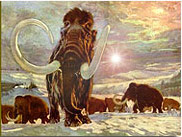I talked once before about the “Clovis Comet” theory, which suggested the widespread extinctions of megafauna in North America at the end of the last ice age was caused by a large comet impact. At the same moment, the highly distinctive “Clovis” archaeological culture was terminated. It was suggested this comet might have either airburst or struck the ice sheets, in either case not causing a visible crater. However, abundant “nanodiamonds”, said to be highly diagnostic of an extraterrestrial impact, were found at a widespread boundary layer roughly associated with the end of Clovis – the start of the Younger Dryas cold period when the earth was suddenly thrust back into near-glacial conditions.
So, I said then and I’ll say again now: this theory didn’t pass the sniff test from the beginning because it is another example of “Clovis exceptionalism” – the skeptical leeway that the Clovis-First model of first peopling of the Americas has been afforded by segments of the archaeological community. No Clovis model was so implausible that it wasn’t given much respectful beard-stroking by the usual silverbacks.
Anyway, subsequent studies of the nanodiamonds and associated evidence have failed utterly to reproduce the findings. Now comes even more news that the comet theory is unsupported and that the original investigators may have mistaken nanodiamonds for, among other things . . . [drumroll] . . . “hardened faecal material from arthropods.”




